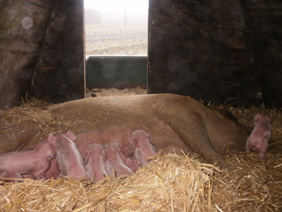Ventilation and thermal comfort

What To Look For:
Enter the shelters/arks regularly to check what the environment is like. Check:
- If the shelter ark is very humid
- Has high ammonia
- Is very cold or hot
- Are pigs huddling together?
- Is straw in lying area very dark and damp?
- Are pigs lying on their sides, far apart, or not lying inside the building?
Whilst outdoor pigs have a greater choice of environments, they still need a warm, dry lying area and protection from cold, wet conditions and draughts as well as a protected shelter from high temperatures and sunburn. Pigs in naturally ventilated systems (eg large, open barns) are at higher risk of tail biting in cold damp conditions.
Additional information:
Enter the shelters/arks regularly to check what the environment is like. Check:
- If the shelter ark is very humid
- Has high ammonia
- Is very cold or hot
- Are pigs huddling together?
- Is straw in lying area very dark and damp?
- Are pigs lying on their sides, far apart, or not lying inside the building?
Whilst outdoor pigs have a greater choice of environments, they still need a warm, dry lying area and protection from cold, wet conditions and draughts as well as a protected shelter from high temperatures and sunburn. Pigs in naturally ventilated systems (eg large, open barns) are at higher risk of tail biting in cold damp conditions.
Suggestions:
Cold shelter: Consider options for reducing draughts and direct flow of cold air onto the pigs, eg internal walls (straw bales), galebreaker or similar fabric awnings (slows movement of air into the shelter, allowing it to warm, reduces rain landing or blowing directly on pigs). Increase dry straw provision. Consider insulation in shelter walls. Consider shielding the doorway (eg a wall of straw bales screening the doorway) to prevent wind blowing straight into the lying area.
Damp straw: If straw being damp is likely to be due to rain entry, shield vents to reduce water entry, or use galebreaker baffles to reduce rain landing or blowing directly onto the straw. If dampness is from contact with wet ground, consider improvements to pen base, or raising the lying area. Use of an apron outside the shelter eg straw, shavings or hard standing can help reduce mud being trodden into the lying area. Ensure the shelter/ark has good drainage.
High temperatures: Increase airflow through the shelter, eg ridge vents, opening side vents. White-painted buildings reflect more heat to keep the inside cooler. Provide additional external shade if the main shelter is likely to become too hot – eg awnings/tent. Insulation of shelters can help prevent inside becoming too hot.
High ammonia: Measures to reduce damp straw and high temperatures are both applicable – the aim is to improve ventilation and reduce humidity. However, it is also necessary to look at why pigs are choosing to dung in the shelter rather than outside, or whether urine and dung are seeping in from outside.
If ventilation is a recurring issue, look at reorientating the shelters to avoid prevailing wind and rain entry in winter.
Additional material:
N/A
